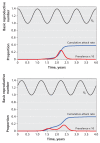Modelling an influenza pandemic: A guide for the perplexed
- PMID: 19620267
- PMCID: PMC2717691
- DOI: 10.1503/cmaj.090885
Modelling an influenza pandemic: A guide for the perplexed
Figures



References
-
- World now at the start of 2009 influenza pandemic [press release] Geneva (Switzerland): World Health Organization; 2009. Jun 11, [(accessed 2009 June 22)]. Available: www.who.int/mediacentre/news/statements/2009/h1n1_pandemic_phase6_200906....
-
- Brauer F. Compartmental models in epidemiology. In: Brauer F, van den Driessche P, Wu J, editors. Mathematical epidemiology. Berlin (Germany): Springer-Verlag; 2008. pp. 19–79.
Publication types
MeSH terms
LinkOut - more resources
Full Text Sources
Other Literature Sources
Medical
